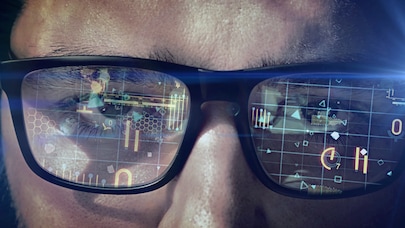Industry 5.0

How can you combine the creativity of humans with the efficiency of machines?
With human-centric networks that bring both together, intelligently.
The information age is truly upon us with Industry 5.0 set to take us further, faster – shifting from process automation to a human-centric, collaborative and more sustainable approach.
Even though it took more than a century to move from one industrial revolution to the next, Industry 4.0 has advanced quickly. Digitalization has expanded dramatically through technology advancements in automation, robotization, data analytics, virtualization, artificial intelligence (AI), machine learning (ML) and devices. Industry 5.0 integrates resilient, sustainable, and human-centric technologies, organizational concepts, and management principles to improve ecosystems, supply chains and operations across industries.
Industry 5.0 builds on Industry 4.0 where the priority has been automation, to focus more broadly on a human-centric approach, cross-sector collaboration, a circular economy and a shared vision of utilizing technology for a better future. Industry 5.0 will take advantage of human expertise and creativity to collaborate with machines, algorithms, and cognitive systems so that they can perform a large portion of tasks with resource-efficient operating solutions. The digital technologies in Industry 5.0 are also present in Industry 4.0. However, they provide additional value when considered from the resilience, sustainability, and human-centric perspectives. Industry 5.0 does not replace Industry 4.0 but supplements and expands it.
The collaborative robot (cobot) market is expected to be worth $6.8 billion by 2029, growing at a CAGR of 34.3% during the forecast period.
According to Siemens the projected value of global digital twin market in 2026, reflecting a compound annual growth rate of 58% from $3 billion in 2020.
The cost of workplace injuries is tremendous and estimated at 4% of the world’s GDP, according to the International Labour Organization. Robots and cobots will lower the number of injuries.
Service providers
Get the insights
Service providers have a significant opportunity to facilitate and strengthen the adoption of Industry 5.0 across a wide range of organizations. Data connectivity and communication will be critical to the smooth operation of Industry 5.0 technologies, whether enabling digital twins or increasing the effectiveness of cobots.
6G networks will deliver ultra-high data rates, ultra-low latency, ultra-high reliability, high energy efficiency, traffic capacity and other capabilities for industry 5.0 applications and use cases.
Private wireless networks will deliver localized, use case-specific network services. With 5G, private wireless networks can be used in many industries such as hospitals, schools and universities to deliver location-specific connectivity solutions. The integration of AI and blockchain would optimize the deployment of private wireless networks for industry 5.0 for cost effective deployment and wide adoption.
To continue the development of XR technologies toward industry 5.0, it will be vital to focus on zero-touch networking, edge computing, highly capable devices, and the enhancement of communications capabilities.
Service providers play a pivotal role in the delivering digital twin services, including designing, developing, deploying, and integrating these to the customers’ IT/OT workflow.
Priorities
- Create an effective edge computing ecosystem, delivering the power of cloud at the front door of the industry and enabling a low-latency network environment, which will be key to productizing Industry 5.0 applications.
- The convergence of OT and IT environments, coupled with other Industry 5.0 applications including digital twins and cobots, will render the industrial network more vulnerable to security attacks. Service providers could develop and provide cybersecurity services to protect Industry 5.0 apps from potential cyber threats, ensuring the safety and integrity of their operations.
- Despite the value it brings to enterprises and industries, Industry 5.0 is increasingly complex and challenging to implement. Besides network connectivity, enterprises need to consider application design, software engineering, power and battery ecosystems, subject matter expertise around big data, analytics, and security, creating a huge vendor ecosystem to navigate. Service providers can build a successful professional services business around Industry 5.0 and detangle this for the enterprise as a one-stop shop.
- Accelerated deployment of fiber and non-terrestrial networks with innovative funding models like exploring partnerships with industry ecosystems, private investors, and government bodies This is critical for catering to the high demand for reliable connectivity solutions for industries like power generation, mining, etc., typically located in areas of lower population where commercial 5G networks make less economic sense.
- Service providers have the potential to monetize various assets and services, including user data, in the industry 5.0 context. Data can be leveraged to optimize collaboration between humans and robots, improving productivity and the quality of work. Bundle this data management and actionable insights with network connectivity for enterprises creating new revenue streams.
Enterprises
Get the insights
Service providers have a significant opportunity to facilitate and strengthen the adoption of Industry 5.0 across a wide range of organizations. Data connectivity and communication will be critical to the smooth operation of Industry 5.0 technologies, whether enabling digital twins or increasing the effectiveness of cobots.
6G networks will deliver ultra-high data rates, ultra-low latency, ultra-high reliability, high energy efficiency, traffic capacity and other capabilities for industry 5.0 applications and use cases.
Private wireless networks will deliver localized, use case-specific network services. With 5G, private wireless networks can be used in many industries such as hospitals, schools and universities to deliver location-specific connectivity solutions. The integration of AI and blockchain would optimize the deployment of private wireless networks for industry 5.0 for cost effective deployment and wide adoption.
To continue the development of XR technologies toward industry 5.0, it will be vital to focus on zero-touch networking, edge computing, highly capable devices, and the enhancement of communications capabilities.
Service providers play a pivotal role in the delivering digital twin services, including designing, developing, deploying, and integrating these to the customers’ IT/OT workflow.
Priorities
- Create an effective edge computing ecosystem, delivering the power of cloud at the front door of the industry and enabling a low-latency network environment, which will be key to productizing Industry 5.0 applications.
- The convergence of OT and IT environments, coupled with other Industry 5.0 applications including digital twins and cobots, will render the industrial network more vulnerable to security attacks. Service providers could develop and provide cybersecurity services to protect Industry 5.0 apps from potential cyber threats, ensuring the safety and integrity of their operations.
- Despite the value it brings to enterprises and industries, Industry 5.0 is increasingly complex and challenging to implement. Besides network connectivity, enterprises need to consider application design, software engineering, power and battery ecosystems, subject matter expertise around big data, analytics, and security, creating a huge vendor ecosystem to navigate. Service providers can build a successful professional services business around Industry 5.0 and detangle this for the enterprise as a one-stop shop.
- Accelerated deployment of fiber and non-terrestrial networks with innovative funding models like exploring partnerships with industry ecosystems, private investors, and government bodies This is critical for catering to the high demand for reliable connectivity solutions for industries like power generation, mining, etc., typically located in areas of lower population where commercial 5G networks make less economic sense.
- Service providers have the potential to monetize various assets and services, including user data, in the industry 5.0 context. Data can be leveraged to optimize collaboration between humans and robots, improving productivity and the quality of work. Bundle this data management and actionable insights with network connectivity for enterprises creating new revenue streams.
Get the insights
Cobots will take care of the repetitive tasks, freeing up humans to put their efforts into being more creative and coming up with innovative solutions to day-to-day business problems. The use of cobots to supplement human labor will be preferable to industries, as cobots designed to work safely alongside humans will take on hazardous, dirty, or ergonomically challenging tasks, reducing the risk of workplace injuries and thus creating a better engaged and productive workforce while improving profitability.
The connectivity of networks and the transfer and protection of data can all become more complicated as a result of this. For businesses to achieve their goals of optimizing the availability and security of their applications as well as the reliability and performance of their infrastructure, they will need to develop comprehensive multi-cloud network strategies.
Edge computing will allow the industry to reduce latency and network bandwidth, improve data security and privacy, and speed up transactions that have been slowed by connectivity issues.
The cost of workplace injuries is tremendous and estimated at 4% of the world’s GDP, which is much higher for a lot of industries. In this new paradigm machines can handle hazardous or repetitive tasks that pose risks to worker safety, reducing the risk of injuries or workplace accidents and associated costs. Machines will provide real-time data analytics and insights, enabling workers to make more informed and effective decisions. By automating repetitive tasks, workers will focus on tasks that require human skills such as creativity and critical thinking, making the work more challenging and interesting.
As the costs of energy continue to soar in the majority of countries, discussing this topic has quickly become one of the most important aspects of the development of Industry 5.0. Energy management will be even more important in this next iteration of the industrial revolution. This is because of the pressure that is being put on companies to reduce their carbon footprint and diversify towards more sustainable technology.
Priorities
- Consider AR and VR as part of your overall Industry 5.0 strategy. These XR technologies have been gaining traction and offer immersive experiences that can significantly impact various sectors of industry, providing new ways to interact with information and the surrounding environment. They can add immense value in areas such as industrial product design, maintenance and repair, remote assistance, etc. Successfully adopting these technologies in an industrial setting could catapult the human-cobot to unprecedented levels.
- Create digital twins of energy systems to optimize energy procurement, distribution, and consumption.
- Implement predictive maintenance strategies for energy infrastructure to reduce outages and improve reliability.
- It is essential to have the experience and knowledge required to make informed choices, aiming to optimize production processes and achieve superior results. Develop plans to upskill and re-skill workers, especially in digital, cloud, and converged IT and OT technologies.
- The convergence of IT and OT could lead to an increased attack surface. Fortifying cybersecurity measures to safeguard sensitive data and ensure the secure operation of digitally connected systems should be one of the top priorities of enterprises and industries. Automation magnifies productivity but consumes data as currency! Utilizing big data analytics to derive actionable insights for better decision-making and predictive analysis will supercharge Industry 5.0 outcomes for industries. Work with your CSPs and other ecosystem suppliers to leverage their capabilities in the domain.
What’s next?
Nokia is continuously innovating in an ever-changing tech landscape, assisting companies in delivering advanced, hyperconnected customer experiences. We are helping companies address constantly evolving technology in an accelerating race to deliver in the most advanced, hyperconnected and seamless experiences for their customers.
We’ll help you understand what is needed to evolve and safeguard your IT, operations, and network infrastructure to prepare to safeguard and ensure your future business success.





